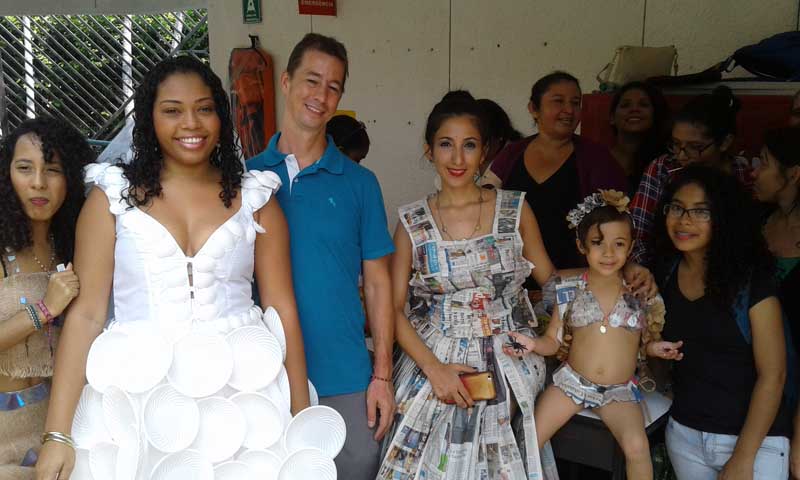Teaching English in Bucaramanga, Colombia: Q&A with Jeremy Krause
Written By: Jeremy Krause | Updated: June 29, 2023
Written By: Jeremy Krause
Updated: June 29, 2023

What is your citizenship and where are you from?
American citizen from Appleton, Wisconsin, USA.
How old are you?
48.
What is your educational background?
Master's degree or higher.
If you've traveled abroad, where have you been?
I have traveled to Spain, Italy, France, the UK, Peru, and Thailand.
What sparked your interested in teaching English abroad?
I have always enjoyed traveling. In my youth, I didn’t have a passport and didn’t have the funds to leave the country aside from brief trips to Canada. As an adult, I was fortunate enough to have opportunities to travel to Europe, Asia and Latin America. I was always disappointed to return home after visiting other places and seeing other cultures. In 2012, I decided to take my career as an ESL teacher overseas. It took a while to finalize a lot of loose ends in my life, including completion of a TEFL course. I was finally able to leave the US toward the end of 2016, and after the holiday season, I got on a plane for Bogotá, ready to begin a new life.
What were some of your concerns before teaching English abroad?
My main concerns were finding employment and housing. This isn’t unique to moving abroad, and I would have had these concerns even if I was just moving to Ohio or Colorado. I was worried, though, about working through the process of finding a place to live, applying for jobs, in a foreign culture. Specific to Latin America, I was really concerned about communicating with prospective employers or landlords in a timely manner. I’m from the Midwest, where people generally work quickly and efficiently and my experience with Hispanics in the US taught me that Latinos have a different sense of time and urgency. I imagined waiting days or weeks for people to return my phone calls as I went out in search of these two all- important things: housing and employment. I was also concerned about the language. I was fluent in Spanish before I left the US, but conversational Spanish and language appropriate for professional interviews are very different.
What did your friends and family think about you moving and teaching abroad?
My family and friends were generally supportive of me. My family, of course, was disappointed that I would be moving farther away because they thought it would be hard for me to communicate and visit. Many of my friends were envious. The most common reaction was amazement, just because packing up your life and leaving for another country is a huge project that most people can’t do.
Why did you decide to get TEFL certified and choose International TEFL Academy?
Before leaving the US, I looked through a lot of job postings for English teachers in foreign countries. Many of them asked for TEFL or CELTA certificates. When I investigated these two programs, TEFL seemed to be more student oriented and CELTA seemed to be more language (academic) oriented. I enrolled in the TEFL course in early 2016.
Which TEFL certification course did you take?
11-Week Online TEFL Course.
How did you like the course?
I liked the course a lot. At the time, I had already been teaching for 12+ years, so it was a good review of the fundamentals of teaching and best practices.
Honestly, it has been over four years, so I don’t remember in detail the technological aspects of the course. I don’t recall having and trouble accessing or downloading tasks. One thing that I was disappointed in, though, was that many of my peers were reluctant to share in the forums. I think a lot of them were either from other professions and felt intimidated by the thought of posting their thoughts and ideas about teaching. Some of them might have just been shy. I was looking forward to sharing opinions about this or that aspect of classroom teaching and language learning, but many people were only worried about completing each task “correctly”. I think people didn’t understand that, while teaching is a skill that requires you to be knowledgeable about your craft, there is also an art to it, and often there isn’t any absolute right or wrong way to do teach.
How has your TEFL training helped you in your current teaching position?
As mentioned above, the TEFL training was a fantastic review of the fundamentals of teaching and language learning. It reminded me a many things that I had forgotten, and reignited my passion for teaching in general.
Where did you decide to teach English?
I decided to teach English in Santa Marta, Magdalena, Colombia. I have been here since February of 2017 and have no immediate plans to leave.
Why did you decide to teach English in this location?
Frankly, I didn’t have a choice. When I arrived in Colombia, I enrolled in a program that was part of a public/ private initiative between the Colombian government and Volunteers Colombia (and NGO). There were about one hundred teachers in my cohort, native English speakers from all over the world. We were all placed in locations where there was a need for English teachers. I was assigned to Santa Marta. I did not like it at all for the first month or two. Soon, though, I grew to love it. After the presidential election of 2018, the program was dismantled, and I had to look for work elsewhere. It really broke my heart to leave Santa Marta.
What was the name of the school you taught at and during which months do they typically hire?
I currently now work for the University Autonoma of Bucaramanga. Locals here call it UNAB. I should note that I was in Colombia for almost two years before I received my current position. I believe the hiring season is usually in the last few months of the calendar year.
Did you secure your position in advance of arriving?
No.
How did you interview for this position?
In-person interview
Did you experience any ageism during your job search and interview process?
I did not experience any overt ageism. My impression of Colombian culture, is that when it comes to professional careers, they value experience and education/training more than age. This may not be true in other professions, but it certainly seems to be the case when it comes to teaching.
What kind of visa did you enter on and what was the process?
I entered Colombia on a tourist visa, which allows you to stay, but not work. When I worked for the NGO, that organization helped with the visa process, and I soon got a Type M (Migrant) visa. This visa expired at the end of each working contract (typically one year) and I’ve had to renew it four times. After five uninterrupted years as a legal Type M visa holder, I can apply for a resident visa, which lasts indefinitely. My short term goal is to apply for this Type R visa in early 2022.
From 2017 – 2018 the NGO, that organization helped with the visa process. In 2019, I had to do everything independently. This involves (1) filling out an application on line, which asks you to include several documents (passport, entry stamps, past visa, power of attorney, work contract, bank statements from your employer (to verify that they are a company viable enough to sponsor your application). The application fee is $52 USD. Once approved, the visa costs $232 USD. Each time I have applied, they have asked me to provide additional documents before I was finally approved. Some of these include, document certifying that I have contributed to a pension plan, document verifying that I have national health insurance, and, most recently, an apostilled & translated copy of my teaching credentials. This last item is difficult to do when outside of the US. I would recommend to all prospective overseas teachers to get their documents apostilled before they travel.

What are the qualifications your school requires for teachers?
Master's Degree/PHD.
What is the best way to apply?
In-Person.
Tell us about your English-teaching job!
My first job was teaching at a community college in Santa Marta, Colombia. My current job is at a private four-year university in Bucaramanga, Colombia. I work twenty-five hours a week and make $30/hour. Vacations are from June to mid-July, and December through late January. My students are typical college age, which is from 17 to 23, however there are some older adults in my classes too. In Colombia, students graduate high school at age 17, so there are some students at the university who are younger than those you might find at American colleges.
How did you find somewhere to live and what is it like? Do you have roommates?
Colombian cities are divided into estratos, numbering 1 through 6. I’m not sure the specifics of how they determine if a neighborhood is estrato 2 or 5, but generally, estrato 1 is full of homeless people, stray dogs, and unsafe streets, while estrato 6 is luxury condominiums and gated communities. Municipal utilities and internet services are priced on a sliding scale according to estrato. I live alone in a 70m2 apartment in estrato 4. This is a clean area, relatively crime free, within walking distance to many parks, stores and restaurants. I am very happy here.
The two most common ways Colombians find apartments is through word of mouth or through real estate agencies. Rental agencies generally charge more, as you can imagine. Apartments are priced with a monthly rent (called a canon) and a monthly administration fee with covers building maintenance. Most apartment buildings have a security guard at the door for at least part of the day, many have someone there 24 hours, and obviously this influences the monthly administration fee.
I don’t have experience purchasing property, but I have rented in many places throughout Colombia. On the coast, they generally rely more on handshakes, oral agreements and short contracts. In bigger cities and in the interior they use rental agreements similar to what you might find in the US. By far the most difficult thing for me in renting is finding a cosigner. To act as a cosigner, someone must submit various financial documents, which is, of course, a huge favor to ask of somebody. Most Colombians use family members as cosigners, but as a foreigner, I didn’t have anyone local be my cosigner. That leaves renting directly from a private person as your only option, since they’re not legally required to have formal rental leases. Some people still want a cosigner, or at least some kind of reference, which can be difficult for a foreigner who has recently arrived. With the influx of Venezuelans over the past several years, agencies have cropped up which provide cosigners for a price. I was able to use one of these agencies to secure my current residence.
Did you move abroad with a spouse/partner/child/family, etc?
I relocated to Colombia on my own, I did not have anyone with me. I have a migrant visa, which is tied to my employment contract. My understanding is that each person who wants to come to the country to live needs to qualify on their own for one type of visa or another, whether that be as a student, tourist, employee. A tourist visa does not allow you to legally work here, but there is a huge cash economy that exists under the radar, and it is not difficult to work without the government knowing about it.
Tell us about Bucaramanga!
Cultural aspects: There are a thousand cultural differences here, but I’ll talk about those that can be traced back to the climate. This many sound strange, but the weather influences many many things.
- Colombians take more advantage of public spaces than Americans Since the weather allows people to be outside year round, people are outside relaxing fifty-two weeks out of the year. Parks and plazas are constantly occupied by families, couples, adults and children. Everyone has easy access to soccer fields and basketball courts and it’s generally assumed that most adults practice some sort of sport, just for recreation.
- People dress differently because most places in Colombia are not cold enough to require sweaters and boots, shorts and sleeveless blouses are more common more often. I think part of the reason Colombian woman have a reputation for being so beautiful, is simply because no one is ever seen wearing a bulky winter coat. Summer clothes are generally more flattering for men and women alike. Sandals are not considered strictly casual, and for men, a short sleeves polo is just as acceptable as a dress shirt and tie.
- People move differently. Everyone walks, bikes, and rides motorcycles much more often in Colombia than in North America because it isn’t painful to be outside in the winter. This, in turn, means that there are less obese people. Of course, there are large people world-wide, but there are less here.
- Cities are built differently. Less car ownership has a cascading effect on city living. In many US cities it is extremely inconvenient to get from one place to another if you don’t own a car. In Colombia, cities are planned and built with pedestrians in mind. There are fewer six lane highways that run through the middle of cities. The roads never have snow on them, motorcycles can be used year round, there are fewer huge parking lots. A house in the US with a one car garage is considered small and the little garage would be a disadvantage, but here, it’s perfectly fine because it fits up to three scooters. The lack of cars has not reduced pollution, but it certainly makes a difference in how traffic flows and what the streets look like.
- More fruits and vegetables. The 12-month growing season allows people to have fresh produce year-round. There is more produce to be had, more often, and at cheaper prices. I won’t go so far as to say that Colombians eat healthier than Americans, but they do eat more fruits and vegetables.
- Public conversations Anyone who has lived in northern latitudes knows how difficult is to stand for a chat on the street during the winter. Our heads are usually covered with hats and scarves, and our faces are often pointed down to avoid the wind and watch the icy sidewalk so we don’t slip and fall. This problem doesn’t exist in Colombia, and it’s easier to stop and talk to your neighbors and strangers. Part of the reason come Colombians can sometimes arrive late to places, is because they as they walk along on the way to work, they pause repeatedly to talk to whoever they meet.
- Homelessness. There are a million reasons why there are more homeless people in Colombia than in the US. But I think the lack of in climate weather that prevents people from sleeping outside is part of why homeless people are more visible in Colombia.
- The warm weather allows outdoor shopping areas to flourish year-round. There is no need to pack up makeshift vending areas when the weather gets cold and snowy, and so for 365 days a year there is almost nothing that you can’t find sold on the street. This leads to an increase in independent business owners. Overhead for a ten-meter square spot on the sidewalk is far less than what you’d have to pay to buy or rent a storefront. People in the US like to shop at their local farmers’ market as an alternative to buying food at a major grocery store, but in Colombia, the market is the standard way people shop for food, clothes, small electronics, and just about anything.
Public transportation: It’s infinitely easier to get around in Colombia without a car than in the US. Public transportation is everywhere, and usually runs early and late hours. In most places, buses and bus stations are cleaner than in the US. Taxis are much cheaper and more common. Every major shopping area has a dozen taxis waiting, such that you really only see in the US outside of airports. At the taxi stand, it’s very common for people to share rides going north, south, or toward a given neighborhood. There are also moto-taxis, which are just like taxis, but motorcycles. You can use your own helmet, but every driver also has a helmet they will lend you for the ride. (Helmut use in Colombia is about 99.99%)
Nightlife: Colombians love music and they love to dance. Every city has what’s called a Zona Rosa, or area with a lot of bars, restaurants, and clubs. In the US, many people think dancing is for young people or drunk people. In Colombia, people take it for granted that everyone dances from time to time, even at home. You are not expected to be a good dancer, just to do it.
 Social activities: In Colombia, there are many many many mom-n-pop stores that also serve beer. I tell people to imagine the general store at a family campground or an American convenience store that doesn’t sell gasoline. In every neighborhood it is common for neighbors to sit at tables outside of these stores in the evening drinking beer and sharing gossip. If there’s music (which is most of the time) you often see an old married couple dancing together on the sidewalk.
Social activities: In Colombia, there are many many many mom-n-pop stores that also serve beer. I tell people to imagine the general store at a family campground or an American convenience store that doesn’t sell gasoline. In every neighborhood it is common for neighbors to sit at tables outside of these stores in the evening drinking beer and sharing gossip. If there’s music (which is most of the time) you often see an old married couple dancing together on the sidewalk.
Food: I can’t say that Colombian food is as interesting or exotic as Mexican or Thai food. Colombians eat a lot of rice (a lot of rice) and vegetables, and they generally don’t do spicy. The most exotic food in Colombia (aside from particular dishes that I won’t mention here, because this answer would be too long) is the fruit. Colombians drink a lot of fruit juices, and it’s usually fresh. Orange juice, Coconut juice, pineapple juice, raspberry juice, guayaba juice, limeade, and many other fruits that aren’t available in the US and Canada. Street food is everywhere and it’s inexpensive. Of course, not so healthy, often empanadas (which are usually fried), pinchos, which are like kabobs, or arepas, grilled and covered with cheese. The average restaurant serves something similar to American comfort food. E.g. Grilled chicken, pork chops, and flank steak, rice, potatoes, squashes, beets, and beans. Every meal comes with soup, without exception, and the soup is always always homemade. Again, it’s not very exotic, but it’s good quality and always made in house. Chain restaurants are not as common here as in North America, and they’re expensive. Most people who go to restaurants like those are tourists or Colombians who want to go out for an “American style” dinner.
Expat community: The biggest city in Colombia is Bogotá, which has over 10 million people. It probably has the biggest expat community simply because it’s so big. The other city that has a large expat community is Medellin. Medellin is a very nice city full of parks, museums, and boasts Colombia’s only public rail system (it’s like an elevated subway). It is so nice, in fact, that many expats go there and stay, without seeing much of the rest of the country aside from weekend trips. When I look at online groups, the question always comes up “where should I move to when I come to Colombia”, and I am always skeptical when I see a hundred people answer “Medellin”. While it is a nice city, yes, it is very over represented among expats. I live in a city called Bucaramanga, in the northeast, about eight hours from the Venezuelan border. Here, there are relatively few expats, and we are spread out among the whole metro area. There is no expat neighborhood. We support each other as much as we can through online chat groups and occasional get together at Christmas, but even before the pandemic we didn’t see much of each other. In my city gringos are unusual, and I very rarely speak English to anyone.
Dating scene: The concept of men and women having platonic relationships is relatively new here compared to North American societies. Men and women can definitely be friends, but foreigners need to be careful, because unless that’s made explicit, when you exchange phone numbers with someone of the opposite gender, the assumption is that you’re interested in each other. It’s not as common for Colombians to date for recreation the way Americans and Canadians do. Dating is a means to finding a spouse. Where it’s easy to find a 23-year-old American college student who has had four or five boyfriends over the years, in Colombia someone that age would only have had one or two serious relationships, and one of them is her husband. People generally marry younger here, about 18-22, and they don’t often wait to have children. Of course, this is changing, as more women enter universities and the work force, but starting a family seems to be a higher priority among both men and women in Colombia than many younger people in North America.
Travel opportunities: Colombians love to travel within their own country. Because of the mountainous terrain, many cities and regions were isolated for the first few hundred years of Colombian history. That means that regional differences like music, accents, food, and lifestyle can be drastic. Colombia has many many different types of landscapes, just like the US, although it’s only about one third the size. There are several motor coach companies that are relatively inexpensive, and these busses are a lot like Greyhounds in the US. Colombians fly a lot, because the flights are usually inexpensive and it never takes more than an hour or so to arrive somewhere else within the country. By far the most common tourist destinations for Colombians are the beaches on the Caribbean coast.
What were your monthly expenses?
- 750.000 COP rent (roughly $210 USD)
- 200.000 COP utilities (roughly $55 USD)
- 200.000 COP General living and entertainment expenses (roughly $55 USD)
How would you describe your standard of living there?
I live a life very similar to how I lived in Raleigh, NC. That is to say, I have an income that allows me to pay all my bills with no worries, I eat well, and I have enough disposable income to lead a fairly comfortable middle class life. Before the pandemic, I had no trouble affording regular vacations within Colombia. This is all relative, though, I am by no means rich, and I don’t buy luxury items. I am a 40+ single man, and I generally don’t have the need for classy clothes or fancy dinners. Someone with more expensive tastes might struggle on my income.
How do you handle insurance and health care abroad?
I am enrolled in the national insurance program, and my premiums are 100% paid for by my employer. Medical costs in general are much cheaper here than in the U.S. For example, in 2020 I had to have a benign tumor removed and it costs the insurance company 149,000 pesos, which is about $42 USD. My personal cost was nothing. Many other expats have told me that they pay for their routine preventative medical costs out of pocket.
What advice would you give someone planning or considering teaching abroad?
I would definitely recommend teaching here in Colombia. Teaching in Colombia is considered an upper class profession and teachers, in general, are much more respected here than in the US. The unspoken feeling among many Americans that “those who can’t do, teach” is an alien concept here. While teachers in US schools are constantly questioned by parents and administration, here it is generally assumed that teachers are educated professionals and they know what they’re doing.
For a qualified and experienced teacher, work is not difficult to find. I must emphasize qualified (e.g.: with an education degree, or minimum TEFL certificate) and experience. Employers here tend to value (1) University degrees (2) Teaching experience (3) Native English speakers, in that order. Age does not seem to be a major factor in hiring. Of course if a candidate is only a few years away from retirement, that would count against him/her, but that isn’t a matter of age, but rather potential longevity with the school. There is a large amount of English speakers - mostly younger - with limited formal teacher training and experience who are competing for teaching positions in Colombia. Obviously, if their primary qualification is being a native English speaker, their opportunities are much more limited than a mature teacher with years of classroom experience.
Posted In: Teach English in Colombia, Teach English in Latin America, Teaching Abroad Over 40, Bucaramanga
Jeremy Krause
Jeremy graduated high school in 1990 and spent most of the next decade traveling and attending the University of Wisconsin. He received his BA in English in 1997, but rather than use his degree to further his career, he continued to work as a chef. In 2001, Jeremy went back to graduate school and enrolled in a teacher education program. From 2004 to 2016, he worked as an ESL teacher in US public schools while traveling overseas regularly. In February of 2017, Jeremy moved to Colombia to teach English at a community college in Santa Marta and is currently an English Professor at the Universidad Autonoma of Bucaramanga.
Want to Learn More About Teaching English Abroad & Online?
Request a free brochure or call 773-634-9900 to speak with an expert advisor about all aspects of TEFL certification and teaching English abroad or online, including the hiring process, salaries, visas, TEFL class options, job placement assistance and more.
"I knew International TEFL Academy had a good reputation, and a friend recommended them to me, so I decided to finally get my certification in order to become a better teacher and be more confident in my teaching skills."

- Laura Hoppe
Teaches English in Colombia







